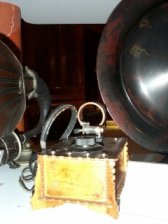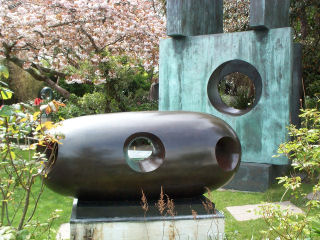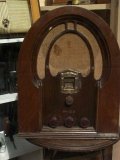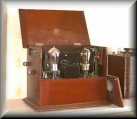Sound - sound effects - sound events
| INTRODUCTION TO SOUND IN FILM AND THEATRE ETC. (below) |
| List of sounds in categories for radio drama (below) |
| LEARN ABOUT THE PHYSICS (or science) OF SOUND (below) |
| Fictionalisation of sound - see Darren Copeland's Ten Questions for a Listener - comments - learning about sound and listening (to another page on this site) |
| Listening - how people listen (to another page on this site) |
| Film Sound Terminology at http://www.filmsound.org/terminology.htm |
| Randy Thom articles about film sound at http://www.filmsound.org/randythom/ |
| Acoustics FAQ at http://www.faqs.org/faqs/physics-faq/acoustics/ |

INTRODUCTION TO SOUND IN FILM AND THEATRE ETC.
For sound effects in film and theatre, and a general introduction,
see (Wikipedia):
http://www.answers.com/topic/sound-effect

Meat safe microphone 1924 - from the side - heavy mic is suspended
List of sounds in categories for radio drama
| vocal sounds - human speech - dialogue - the voice stream |
| vocalising from animals and insects, sound-making from insects (barking, mooing, insect shrieking, scratching). |
| non-vocalised sounds of human origin (scratching, clothes rustling, footsteps) - these indicate the 'more than words' (or embodying the dialogue) - representing living in the vocal stream (Beck, Radio Acting, 61). |
| Non-vocalised sound events of sentient beings which are non-human (animals moving, insects clicking) |
| Sound events not originating from living beings, that is originating from nonsentient objects (stones falling, machines, thunder). |
| Music |
| Atmos, background, soundscape, ambient sound, including 'room tone' and the 'aural fingerprint' of locations |
| Silence(s). Stearns, 1995 describes silence as: 'A dramatic element. It can be very loud.' (See Shingler and Wieringa, 1998, 54 for a revealing discussion.) See silences - different sorts and Silences and the overall design |

|
LEARN ABOUT THE PHYSICS OF SOUND Sound requires a medium to exist. There is no sound when a space ship explodes in deep space. Air molecules provide the necessary element for sound transmission to occur. BELOW FROM - Acoustics FAQ at http://www.faqs.org/faqs/physics-faq/acoustics/ *** 2.1 What is sound ? Sound is the quickly varying pressure wave within a medium.
We usually mean audible sound, which is the sensation (as detected
by What makes sound? *** 2.6 How does the ear work ? The eardrum is connected by three small jointed bones in the
air-filled middle ear to the oval window of the inner ear or
cochlea, a fluid- The basilar membrane is wider at its apex than at its base,
near the oval window, whereas the cochlea tapers towards its
apex. Different *** 2.9 How does sound decay with distance ? The way sound changes with distance from the source is dependent
on the size and shape of the source and also the surrounding
environment and If the noise source is outdoors and its dimensions are small
compared with the distance to the monitoring position (ideally
a point source), then as the sound energy is radiated it will
spread over an area which is proportional to the square of the
distance. This is an 'inverse square law' where the sound level
will decline by 6dB for each doubling Line noise sources such as a long line of moving traffic will radiate noise in cylindrical pattern, so that the area covered by the sound energy spread is directly proportional to the distance and the sound will decline by 3dB per doubling of distance. Close to a source (the near field) the change in SPL will not follow the above laws because the spread of energy is less, and smaller changes of sound level with distance should be expected. In addition it is always necessary to take into account attenuation
due to the absorption of sound by the air, which may be substantial
at higher frequencies. For ultrasound, air absorption may well
be the dominant factor in the reduction. |

|
Human hearing at http://www.answers.com/main/ntquery?method=4&dsid=2222&dekey=Hearing+%28sense%29&gwp=8&curtab=2222_1&linktext=hearing |
| Decibels at http://www.answers.com/main/ntquery?method=4&dsid=2222&dekey=Decibel&gwp=8&curtab=2222_1&linktext=decibels |
|
|



